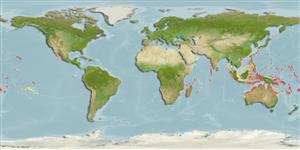>
Ovalentaria/misc (Various families in series Ovalentaria) >
Pomacentridae (Damselfishes) > Microspathodontinae
Etymology: Stegastes: Greek, stegastos, -e, -on = covered (Ref. 45335).
More on authors: Schlegel & Müller.
Environment: milieu / Zona climática / intervalo de profundidade / distribution range
Ecologia
marinhas associadas(os) a recifes; não migratória; intervalo de profundidade 0 - 4 m (Ref. 1602). Tropical; 35°N - 35°S
Indo-Pacific: Seychelles and Reunion to the Line and Tuamoto islands, north to the Ryukyu Islands, south to New Caledonia.
Tamanho / Peso / Idade
Maturidade: Lm ? range ? - ? cm
Max length : 13.0 cm TL macho/indeterminado; (Ref. 9710)
Espinhos dorsais (total) : 12; Raios dorsais (total) : 15 - 16; Espinhos anais: 2; Raios anais : 12 - 14. Diagnosis: Body dark brown to blackish; suborbital mostly blue with blue spots on side of head; most scales on side of body with blue transverse streak. Fins dark brown to blackish except pectorals which are translucent with dusky rays. Pectorals with scaly inner base and has pupil-sized black spot at the base of uppermost rays; a black spot (maybe bordered anteriorly with white) at base of posterior dorsal rays, slightly extending onto dorsal edge of caudal peduncle; with or without white bar across posterior half of body (Ref. 510). Body depth 1.8-2.1 in SL (Ref. 90102).
Body shape (shape guide): short and / or deep; Cross section: oval.
A territorial herbivore. Adults inhabit reef flats, shallow lagoons, and semi-sheltered reef margins; common among patches of rubble or porous reef rock, surrounded by live coral, particularly in areas of mild surge (Ref. 1602). Also in high energy zones with mixed corals and short algae. They occur in small loose aggregations (Ref. 48636). Feeds on filamentous algae (Ref. 89972). Oviparous, distinct pairing during breeding (Ref. 205). Eggs are demersal and adhere to the substrate (Ref. 205). Males guard and aerate the eggs (Ref. 205).
Ciclo de vida ou comportamento de acasalamento
Maturidade | Reprodução | Desova | Ovos | Fecundidade | Larvas
Oviparous, distinct pairing during breeding (Ref. 205). Eggs are demersal and adhere to the substrate (Ref. 205). Males guard and aerate the eggs (Ref. 205).
Allen, G.R. and A.R. Emery, 1985. A review of the Pomacentrid fishes of the genus Stegastes from the Indo-Pacific, with descriptions of two new species. Indo-Pac. Fish. (3):31. (Ref. 510)
Status na Lista Vermelha da UICN (Ref. 130435: Version 2025-1)
Ameaça para os humanos
Harmless
Uso pelos humanos
Ferramentas
Relatórios especiais
Baixar XML
Fontes da internet
Estimates based on models
Preferred temperature (Ref.
123201): 25.1 - 29.3, mean 28.3 °C (based on 2041 cells).
Índice de diversidade filogenética (Ref.
82804): PD
50 = 0.5000 [Uniqueness, from 0.5 = low to 2.0 = high].
Bayesian length-weight: a=0.02042 (0.01005 - 0.04147), b=2.98 (2.81 - 3.15), in cm total length, based on LWR estimates for this species & Genus-body shape (Ref.
93245).
Nível Trófico (Ref.
69278): 2.0 ±0.00 se; based on food items.
Resiliência (Ref.
120179): Elevada, tempo mínimo de duplicação da população menor que 15 meses (Preliminary K or Fecundity.).
Fishing Vulnerability (Ref.
59153): Low vulnerability (10 of 100).
🛈
Nutrients (Ref.
124155): Calcium = 117 [58, 198] mg/100g; Iron = 0.78 [0.46, 1.38] mg/100g; Protein = 18.1 [16.8, 19.3] %; Omega3 = 0.0839 [, ] g/100g; Selenium = 17.3 [8.9, 37.0] μg/100g; VitaminA = 76.1 [17.7, 308.1] μg/100g; Zinc = 2.06 [1.33, 3.18] mg/100g (wet weight);
